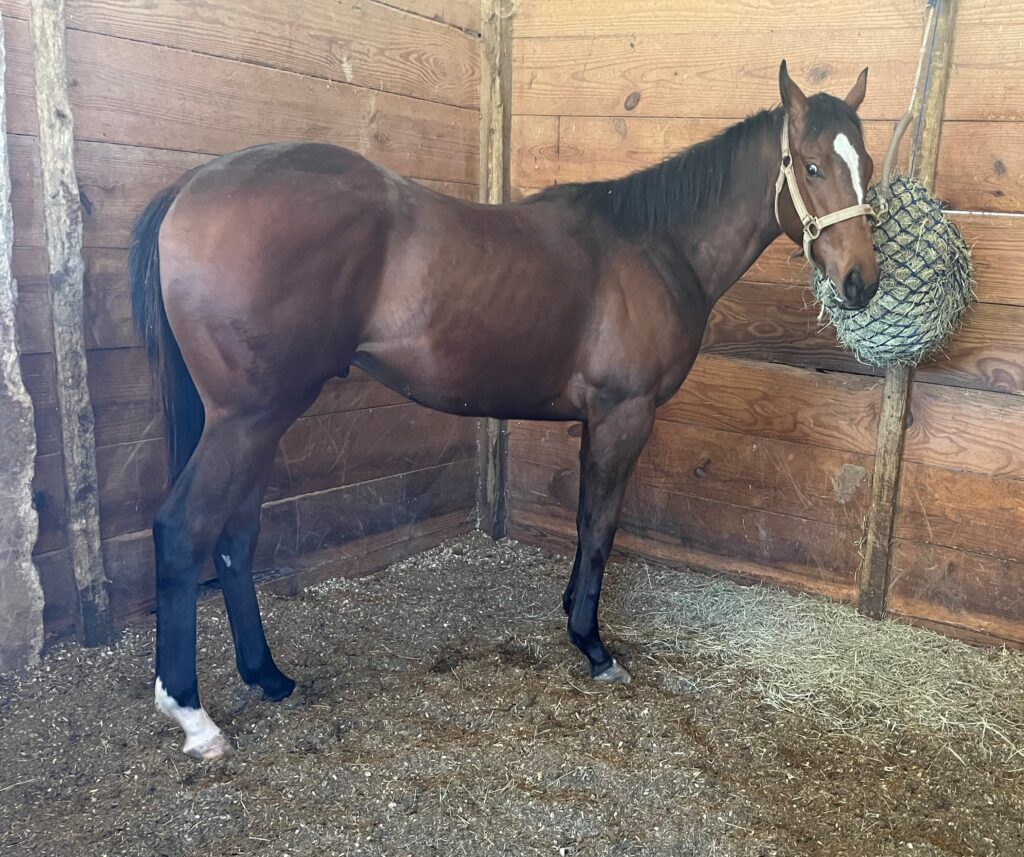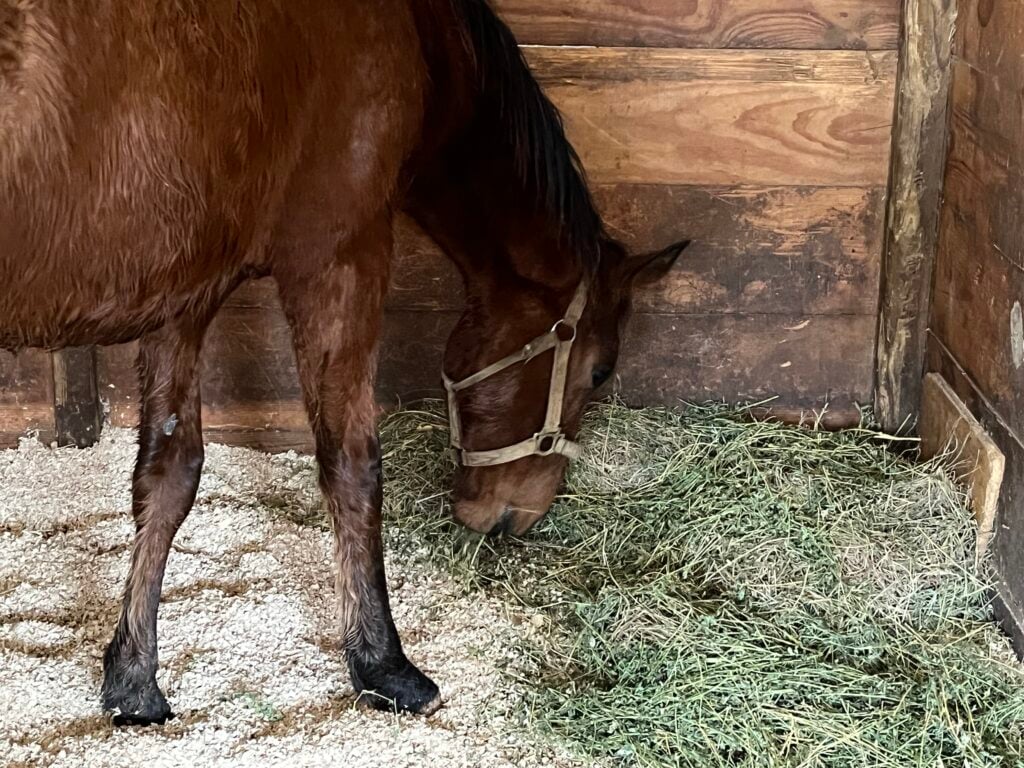Last updated: March 28, 2022
A common dilemma that horse owners often wonder about is whether to feed their horses before or after riding them. It’s easy to get confused at first, but once I did my research, the answer seemed relatively simple.
You should feed your horse hay just before riding or give them grain one to four hours before riding. After riding, you should immediately provide them hay. However, it would be best to wait for at least half an hour to feed them grain.
It’s essential to get the timing right if you are relying on grain-based diets. Depending on the horse’s exercise and its regular diet, grain may or may not be a good option. Let’s learn more below.

Riding a horse on an empty stomach
First things first, what difference does it make if you ride a horse on an empty stomach vs. a partially full one? One thing is clear; riding a horse on an empty stomach is never a favorable option.
A horse’s stomach continuously produces digestive acid, even when it’s not eating anything. Riding a horse on an empty stomach makes this acid jump around and damage the stomach, often resulting in stomach ulcers and other painful conditions.
A horse’s anatomy is designed to consume feed slowly. In nature, a horse takes its time moving around and looking for suitable grass. It tears the grass, chews it thoroughly, and swallows it, then moves on to find and eat more grass.
Their bodies demand a constant supply of small amounts of feed eaten over a long period. In fact, horses may spend up to 10 – 14 hours only grazing and digesting their food in the wild. You have to keep this fact in mind when managing your horse’s diet.
As a result, a horse’s stomach continuously secretes acid to support digestion, even when it’s not ingesting any food. This acid is made at the lower part of the stomach, so naturally, that part isn’t vulnerable to the acid’s effects.
However, the upper part of the stomach doesn’t have any protective layer to guard against the acid.
When a horse is not fed for some time, the acid gathers in the stomach. And when you ride the horse, the stomach acid stirs up and can reach the stomach’s upper, unprotected part. The acid regularly contacting the upper stomach increases the risk of your horse developing gastric ulcers.
Gastric ulcers can be severe, and one way to avoid them is not riding or exercising your horse on an empty stomach.
I’ve noticed that my horses are more focused and easier to work when I give them something to eat before riding. In contrast, if I routinely feed a horse only after I’ve ridden it, it learns to hastily get done with its tasks so it can rush back to the barn and devour its food.
You don’t want a horse eating too fast or too much because they often get sick. Keep in mind, horses’ digestive system is designed to take in a small amount over a large amount of time.

How long should you wait to ride a horse after it eats?
How long I should wait to feed my horse after riding is a question that’s perplexed me for a while. After all, many people believe we should avoid intense exercise soon after eating. Does this apply to horses too?
If a horse has eaten hay, you don’t need to wait to ride it at all – hay is actually better than an empty stomach. However, if the horse has eaten grain, wait at least three hours before riding because the grain is harder to digest.
Hay or grain-based feed is what most horses eat. It’s essential to understand how their bodies react to each of these foods.
Hay is what horses are meant to eat in the wild. It needs to be chewed up and broken down before they can swallow and process it. It isn’t as tasty as grain either.
Because they have to chew thoroughly and hay isn’t very flavorful, horses aren’t likely to overfill their bellies even with unfettered access. In fact, free-feeding hay is part of an ideal feeding plan.
Because horses typically don’t have a full belly, when you take your horse riding, there aren’t any significant concerns of it underperforming due to extra weight or lethargy.
Most importantly, hay counteracts the harmful effects of stomach acid. When you ride your horse after it has consumed hay, the acid in its stomach attacks the hay instead of dangerously sloshing around. Also, the slow chewing of the hay produces saliva, which acts to dilute the acid.
Thus, hay decreases the chances of ulcers caused by stomach acid. And as the horse isn’t starving, it will be more comfortable riding along with you and less intent on getting back to its food.

Feeding a horse grain before riding.
Giving a horse grain-based feed to eat before riding is quite different than giving it roughage. Grains are rich in sugar, and horses are often prone to overfeeding on it, in which case, they may develop severe conditions like colic and laminitis.
Riding a horse sooner than four hours after feeding it grain can hamper the digestion process and make physical exertion difficult as the blood flows away from the digestive system and levels of body fuels decrease temporarily.
Usually, horses don’t need grain, but horses that eat grain typically have a spike in insulin levels. The consequence of this increased insulin is that the horse won’t properly burn its body fat or glucose for some hours. Thus, it won’t be fit for exercises and will quickly tire when ridden.
One study showed that feeding horses grain before riding could reduce fatty acids and plasma glucose in their bodies. Both of these compounds are needed to make muscle exertion possible. However, they can take up to four hours to reach their normal levels after the horse has eaten grain.
I usually keep my horses away from grain unless they are in regular training and need the extra energy. Otherwise, the horses do best on a straightforward diet of pasture grass and hay.
Feeding a horse after exercise.
It may seem intuitive to feed a horse after exercise. That is true for the most part, but there are some things you could do to ensure your horse’s best interest.
It would be best if you let your horse eat hay as soon as it’s done with its exercise. You can also feed it grain after 30 to 60 minutes, but only if it’s already accustomed to a grain-based diet.
Remember to watch out for signs of dehydration and give your horse cool water after some time has passed.
When your horse does low-intensity work, its body uses up fats as the primary source of energy. And when it undergoes intense exercise, its body burns the glucose stored in the muscles or “glycogen.”
Glycogen is the primary source of muscle power, and so it needs to be replenished by hay or grain. You can feed hay just after the exercise because horses can easily digest it, and most horses know how to self-regulate the intake of grass.
However, avoid feeding them grain right after exercise. Wait for their bodies to cool down and their breathing to become normal. Your horse is going to need all the energy it can get to digest grain properly.
After exercise, you mustn’t feed grain to a horse not used to eating it. It’s always best to introduce your horse to new types of food slowly, and giving sugar-rich grain to a starving horse that isn’t accustomed to eating grain is a bad idea.

Alfalfa hay is a good option.
Alfalfa pellets or cubes are rich in proteins and minerals. Specifically, calcium is abundant in alfalfa hay, and it has been shown to have a strong resistance to stomach ulcers. If your horse tends to suffer from ulcers, switching to alfalfa before riding might help.
Similarly, alfalfa is relatively high in vitamins and energy. After you’ve ridden your horse, you can feed your horse a flake of alfalfa hay to replenish its energy levels. But, once again, you shouldn’t feed alfalfa or not only alfalfa to your horse if it’s not used to it.
5 Tips for feeding horses before and after riding.
- Don’t ride your horse on an empty stomach
- You can feed your horse hay before riding
- Don’t feed your horse grain right before riding, and
- Don’t feed grain to your horse immediately after riding.
- It’s Ok to give your horse hay after riding.
Final thoughts
I’d advise you to trust common sense and watch for any signs of illness or discomfort that may be unique to your horse. Test with different feeds and their amounts at your vet’s suggestion. Don’t let your horse devour its feed or guzzle water excessively, etc.
FAQ
Can horses eat fresh grass clippings?
Fresh grass clippings are a no-no for horses to eat. They often eat it too fast and it frequently has mold and bacteria. To find out more about this topic check out this article: Why Can’t Horses Eat Cut Grass? Isn’t Hay Grass Clippings?
Will Horses Eat Moldy Hay?
Horses will eat moldy hay if they have no choice, but it’s not healthy. Will Horses Eat Moldy Hay? 7 Essential Facts
How much does a bale of horse hay cost?
A bale of grass hay cost about eight dollars, and alfalfa hay bales are more expensive. To find out more about the cost of hay bales, you may find this article helpful: How Much Does a Bale of Hay Cost for Horses? 5 Price Factors

About the Author: Miles Henry
Lifelong Horseman | Racehorse Owner | Published Author
Miles Henry brings over 25 years of hands-on experience training and owning Thoroughbred racehorses. Raised with Quarter Horses and Appaloosas, he’s spent a lifetime learning from horses—on the track, in the barn, and in the field. Today, he runs a small but successful racing stable in Louisiana and shares real-world insights on HorseRacingSense.com, helping horse owners, fans, and bettors navigate the sport with confidence.
📚 Books: View Miles’s books on Amazon »
🎧 Podcast Guest: Animal Tales Ep. 32 |
YouTube Interview
📩 Newsletter: Sign up for racing tips and horse care advice »
🔗 Follow Miles:
Twitter |
Facebook |
YouTube


